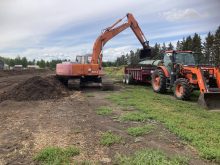The uncertain future of the Canadian Wheat Board means the same for Alberta’s only short line, says the chair of the Battle River Railway.
“I’m trying to fight the good fight,” said Ken Eshpeter. “I’m trying to preserve the wheat board because it’s integral to our short line. We just bought this short line a year ago.”
The central Alberta railway serves the communities of Alliance, Galahad, Forestburg, Heisler, Rosalind and Kelsey, connecting area producers to the CN line at Camrose.
Read Also

Alberta crop insurer says carbon levels can lower costs
AFSC says soil carbon levels could change how much a farmer pays for crop insurance.
Since 2003, a collective of local farmers known as the Battle River Producer Car Group operated as a grain car loader only. When the railway was put up for sale by CN, a new entity known as the Battle River Railway New Generation Cooperative formed and rallied to purchase the line for nearly $5 million. The locally owned short line is the first of its kind in Alberta, although there are 11 such railways in Saskatchewan.
Area producers wanted to keep the line open in order to continue loading producer cars and avoid expensive trucking costs. The Canada Grain Act gives farmers the access to rail cars, but they also need to have rails beneath them, noted Eshpeter.
“Even though the federal government says that producer cars are technically eligible to be spotted, if you don’t have spots where you can spot them, they’re kind of hollow words,” he said.
The Canadian Wheat Board has also been critical to making this system work, and that is why Eshpeter is fearful of the future.
Local producers order cars through the Canadian Grain Commission (CGC), and if the CWB confirms an order exists for the grain, CN is contacted and must oblige by bringing the requested number of cars to Camrose.
“Up to this point, the agencies in place have made this possible, the CWB in conjunction with the CGC,” said Eshpeter. “They more or less, because of legislation, force CN to perform this service.”
An unbiased entity is going to have to take the agencies’ place to ensure cars are allocated and moved to an export position, he said.
“If it is curtailed in any way in its ability to allocate cars to small players, then that is going to be issue No. 1,” said Eshpeter. “Will producer groups, farmers and orderers of producer cars have access to producer cars? And if we get producer cars, who is going to assure that those producer-destined cars are going to be given any degree of priority by the railway to spot those cars?”
Few cars for non-boards
Eshpeter said he has written letters to his MP and others, including David Anderson, a Saskatchewan MP and parliamentary secretary to the agriculture minister, to get answers to those questions.
He said he told Anderson that since 2003, local farmers have loaded 5,000 producer cars, and only 25 have been filled with other commodities, such as peas and canola.
“It’s not because we haven’t been trying, it’s just that we are finding it extremely difficult to find an attractive bid to give to farmers to load canola and peas into producer cars,” said Eshpeter.
“I said to Anderson, ‘under this new commercial scenario, what would prevent the scenario that now exists for canola and peas from starting to happen in wheat where we currently have all of our volume?’ He didn’t even understand the question.”
Anderson was contacted for an interview, but did not return calls by press time. More information on the Battle River Railway can be found at www.bat tleriverrailway.ca.
———
Andifwegetproducercars, whoisgoingtoassurethat thoseproducer-destinedcars aregoingtobegivenanydegree ofprioritybytherailwayto spotthosecars?”
Ken Eshpeter Battle River Railway chair














